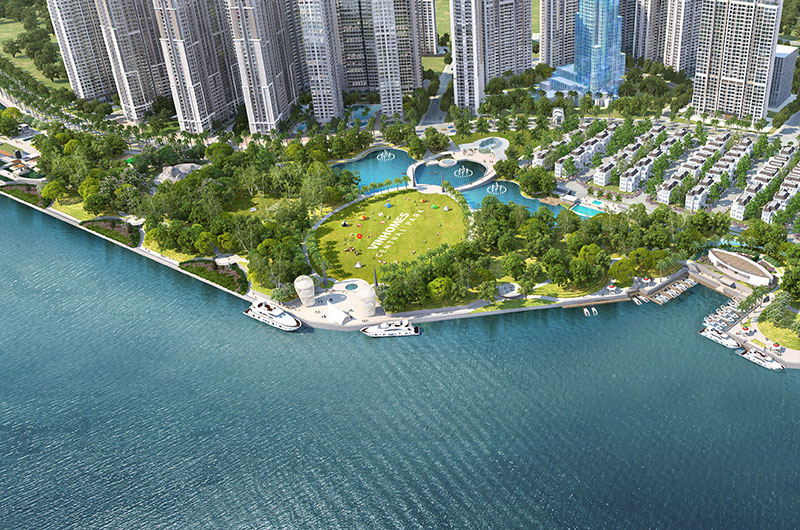“Offshore fishing” in central real estate market
“Offshore fishing” in central real estate market
The ever-increasing development of the transport infrastructure network connecting regions has blurred the spatial boundaries of the real estate market, giving rise to a wave of “offshore fishing” by developers which are looking for potential investment opportunities in the surrounding areas.
Success a few miles down the road
“Only five years ago, the purchase of a property in any province outside Ho Chi Minh City was considered a luxury and a waste of money by most city dwellers. However, the real estate market is now quite different as a person living in Ho Chi Minh City and owning a second home in Nha Trang, Phan Thiet, or Ba Ria-Vung Tau for investment or leisure purposes has become normal and is going to be a trend in the coming time,” said Duong Minh Tien, deputy general director of Danh Khoi Real Estate JSC, a thriving business which has successfully developed a series of real estate projects in the cities of Vung Tau, Phan Thiet, and Nha Trang over the last few years.
According to Tien, since the beginning of 2017, despite steering its real estate development projects towards other cities and surrounding provinces, Danh Khoi remained somewhat hesitant. However, after a couple of successful projects in Phan Thiet and Nha Trang, Tien believes that the company has been following the right direction.
In early 2017, Danh Khoi started the operation of Queen Pearl Mui Ne in the central province of Binh Thuan. Although the project is of a particularly large scale with 1,200 townhouses, within a short time of the launch all the units were purchased.
Following this success, Danh Khoi moved to the central province of Khanh Hoa to develop Haborizon Nha Trang. This carefully-designed project is situated in the area of Hon Ro Hill on Ton Duc Thang Road, adjacent to Nguyen Tat Thanh Boulevard (Nha Trang). By the end of 2017, the project was officially launched to the market and within a single morning nearly 400 houses and villas were sold.
Besides Danh Khoi, since the last few years, especially in 2017, the number of real estate businesses expanding and developing their projects in other cities and provinces outside Ho Chi Minh City has increased. For example, after successful sales of thousands of land plots at the Golden Bay project which covers an area of 79 hectares in northern Cam Ranh Peninsula (Khanh Hoa), in 2017, Hung Thinh Corporation acquired a project from Phat Dat Real Estate Development Corporation, also on the northern Cam Ranh Peninsula, to develop a resort with total investment capital of nearly VND1 trillion ($44.05 million).
Another giant is Greenland Group. In 2017, it officially announced building a 185ha resort and tourism services area called Opal Ocean View with total investment capital of over VND4.6 trillion ($202.64 million) in southern Hoi An in the central province of Quang Nam. Opal Ocean View consists of premier accommodations, ranging from rooms to suites, from vacation villas to beach houses. The hotel resort is a combination of luxury amenities, first-rate tourism services, and a highly synchronous technical infrastructure system.
In addition to the “big names” above, there are a series of real estate giants in Ho Chi Minh City which have been busily (and secretly) expanding the scope of their projects into new markets, such as Phuc Khang Construction and Investment Corporation with a chain of resorts in Phan Thiet, and Novaland Group with a project in Can Tho.
The ace of the niche market
According to industry experts, if Ho Chi Minh City is considered the centre of the southern real estate market, its neighbouring provinces are considered a niche segment.
“Ho Chi Minh City’s real estate market is becoming ever more expensive and over-crowded. As the living standards of the city dwellers are improving, the demand for a happy and peaceful life is also increasing. The number of people working in Ho Chi Minh City on weekdays and spending the weekend resting on the beaches of Nha Trang, Phan Thiet or Ba Ria-Vung Tau has been increasing,” said Tran Le Thanh Hien, general director of Danh Khoi Viet Real Estate Corporation.
At the same time, he added, the development of this niche market will depend on the infrastructure network connecting regions. Localities with well-developed infrastructure will have a developed real estate market.
Apart from focusing on Ho Chi Minh City, many businesses have shifted to other promising destinations, especially to those with great tourism potential such as Vung Tau, Phan Thiet, Nha Trang, Danang, and Phu Quoc.
For example, regarding Phan Thiet, at the recent Binh Thuan Investment Promotion Conference, Prime Minister Nguyen Xuan Phuc reaffirmed that Binh Thuan will be developed into an international marine tourism city. Currently, Phan Thiet in particular and Binh Thuan in general are drawing great attention from many real estate investors thanks to the increasingly complete infrastructure system, such as Ho Chi Minh City-Long Thanh-Dau Giay Expressway, the newly completed renovation project for National Highway 1A, Dau Giay-Phan Thiet Expressway, and Phan Thiet-Nha Trang Expressway. Especially, Phan Thiet Airport has already commenced construction and is expected to be put into operation in 2018.
Tien from Danh Khoi said that the sharp increase in housing prices in Ho Chi Minh City over the last few years is one of the main causes triggering a huge wave of investment in housing and land plots in nearby provinces. In fact, the average housing price in Ho Chi Minh City has increased by 16-40 per cent. In some areas, it was as high as 20-30 per cent, and even reached 50 per cent compared with a year ago. The western part of the city, which used to have stable housing prices, also saw a surge of 20 per cent. Meanwhile, the average land price in nearby provinces only hovers around VND500-800 million ($22,026-35,242) per plot at the moment, which is suitable for many medium-scale developers in Ho Chi Minh City. In addition, the infrastructure system of the city is continuously developing, shortening the travel time between Ho Chi Minh City and neighbouring provinces. This will not only facilitate trade, but investment in the hospitality and tourism industry will also be more convenient and profitable.
Commenting on the trend of investors shifting cash flows to nearby provinces in the coming time, Tien advised, if investors live in Ho Chi Minh City and seek to invest in nearby provinces’ real estate markets, they should choose places within easy reach by car. As housing prices in Ho Chi Minh City are rising sharply, it is likely that in the coming time more cash flows from investors will run into the niche market, of which Ba Ria-Vung Tau, Phan Thiet, Can Tho, and Dong Nai appear to be the most promising destinations.




















